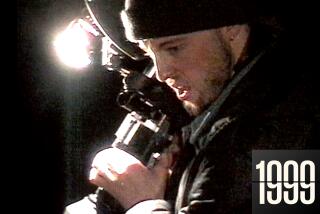Clever Sites Can Boost Films’ Net
- Share via
The typical Web site for a Hollywood movie is a lot like a box of cereal. There’s a list of ingredients, a brief write-up and maybe a contest or form to send in.
“The Blair Witch Project,” however, showed that an inventive Web site can turn a little film into a huge one. Since then, a smattering of movie productions have used the Web to deliver not just trailers and cast bios but also original videos and animations that whet the public’s appetite.
One recent example is the Web site for “The Center of the World,” an adult-oriented movie due next month from Artisan Entertainment, the studio that distributed “Blair Witch.” The film’s adults-only site immerses visitors in the seedy, neon-lighted workplace of one of the movie’s main characters, a stripper.
Director Wayne Wang, who also directed “The Joy Luck Club,” shot footage specifically for the Web site, including an interactive conversation with an actress. Although her comments are canned, they’re not the same for every visitor. Instead, her responses vary according to what visitors type during a simulated chat session.
This is true multimedia: using the unique properties of the Net and the theater to deliver different entertainment experiences. At the theater you watch the action from a distance, but on the Web you can become a participant.
Granted, the Net is handicapped because most consumers still use dial-up modems, which turn video into a herky-jerky slide show. But as the percentage of homes with high-speed connections rises, look for studios and filmmakers to mount more ambitious Web projects.
The growing popularity of DVDs also encourages the industry to develop more original, interactive content for movie-based Web sites. Once the film’s theatrical run is over and the Web site shuts down, the original content can be recycled onto the DVD to boost sales.
“The Center of the World” is a movie for adults because of its subject: a dot-com entrepreneur who becomes obsessed with a stripper. Its explicit Web site puts visitors into the entrepreneur’s shoes and challenges viewers to strike up a friendship with an exotic dancer at a virtual bar.
It’s a game of arm’s length intimacy, which is a central theme in the film, said Amorette Jones, executive vice president of worldwide theatrical marketing for Artisan Pictures Inc. “You’re seeing some very provocative images, but you’re definitely detached because you’re not there [in reality],” she said.
The site reflects Artisan’s approach to the Web, which is to “allow the viewer to get into the mood of the movie,” as Jones put it. There’s no contest or photos of the cast, and the only link to the trailer comes after visitors make their way through the videos on the site.
Artisan and Web designer Hi, Res! took a similar approach to the site for “Requiem for a Dream,” which is more like a hallucinatory nightmare than a set of Web pages. The movie is about a family ravaged by drug addiction, and the site is a mind-bending, frequently incoherent stream of images involving its characters.
Jones said Artisan’s goal is to present “almost a stand-alone piece of entertainment that’s complementary to the picture, but that’s also a piece of entertainment in and of itself.” For Wang, the point was to let visitors “feel like the main character of the movie, and from there, perhaps, become interested in the movie.”
The Web is uniquely suited for this kind of immersion. The more sophisticated sites let visitors explore a virtual environment as if they were physically there, even giving them 360-degree views of video streams. For example, Disney and JesterDigital plan to let Web surfers pilot a virtual seaplane around a 3-D version of Pearl Harbor in support of director Michael Bay’s big-budget spring release, “Pearl Harbor.”
The explicitness of Wang’s new film is a departure from his previous movies, most of which were R-rated independent projects such as “Smoke” and “Chinese Box.” He said the film and the Web site are a reaction of sorts to the repeated demands from studio executives, lawyers, ratings boards and focus groups to cut this and trim that.
“You’re confronted with layers and layers of what’s not possible to do. For this film, I just said, ‘I want to be free of all of this.’ ”
The same attitude extended to the Web site. Of course, it helps that the site didn’t have to cover its production costs (which were a comparatively paltry $40,000), given how hard it’s been to make money off of original content online.
He added, “The Web site is about selling the fantasy, and the film is about fantasy.” Both main characters get sucked into a dream world, he said: instant stock-market riches for the dot-com executive, make-believe love for the stripper.
“If you play with [the Web site] long enough, you realize that the interactive element is kind of a lie and it teases you. It’s striptease. It’s Web tease.”
*
Times staff writer Jon Healey covers the digital living room.
More to Read
The biggest entertainment stories
Get our big stories about Hollywood, film, television, music, arts, culture and more right in your inbox as soon as they publish.
You may occasionally receive promotional content from the Los Angeles Times.











